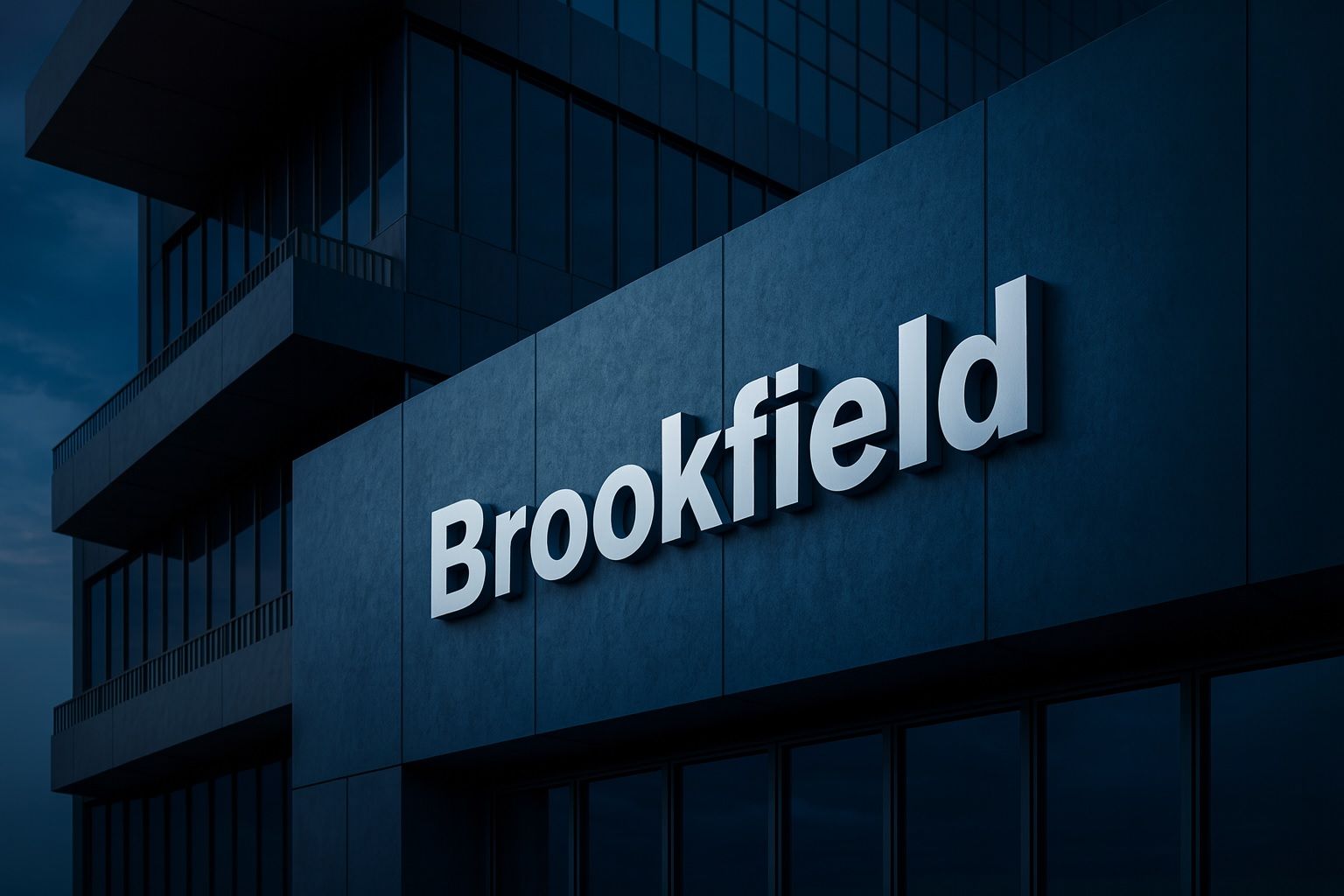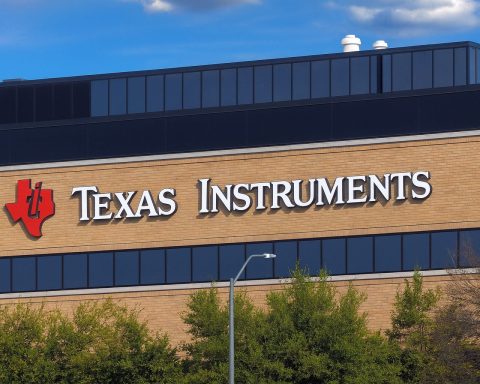- Global Alternative Asset Giant: Brookfield Corporation (TSX: BN, BN.TO) is a leading global alternative asset manager with over $1 trillion in assets under management [1]. Its operations span infrastructure, real estate, renewable power, and private equity investments worldwide [2], with a vast portfolio (e.g. ~100,000 residential units and 500 million sq. ft. of office space) across 30+ countries [3].
- Current Stock Price & Performance: BN.TO trades around C$63 per share as of Oct 10, 2025 (post 3-for-2 stock split) [4]. The stock is near its 52-week high (~C$68) after a strong 2025 rally, up sharply from a ~C$41 low [5]. It reached an all-time high (pre-split) in late September before recent consolidation. Year-to-date, BN has handily outperformed broader indices, reflecting investor optimism.
- Recent Developments: Brookfield completed a 3-for-2 stock split effective Oct 9, 2025 to boost liquidity and accessibility [6]. It also refinanced a $1.25 B Manhattan office tower at a 6.0% fixed rate [7], demonstrating financing ability amid high rates. In M&A, Brookfield joined a $7.4 B cash deal to acquire Air Lease Corp (aircraft leasing) alongside partners [8], and formed a strategic AI infrastructure partnership with robotics startup Figure [9] [10].
- Financials & Dividend: Brookfield’s Q2 2025 results were strong – $1.1 B net income for the quarter (with $1.3 B in distributable earnings) [11] – supported by asset sales and fee-related growth. It offers a small dividend (post-split annualized ≈0.5% yield [12]) as the company prioritizes reinvestment. Market cap stands around C$156 B (≈US$115 B) [13]. Leverage is high (debt-to-equity ~5.4x) [14], and return on equity is modest (<1% TTM [15]), reflecting the firm’s heavy use of debt and accounting adjustments.
- Analyst Sentiment & Outlook: Wall Street maintains a Bullish view on BN. The consensus rating is “Buy” with an average 12-month price target in the mid-$70s (≈20% upside) [16] [17]. Goldman Sachs recently initiated coverage at Buy with a $78 target, citing Brookfield’s undervalued shares and strong growth potential [18]. Experts highlight Brookfield’s 15%+ annual shareholder returns over 30 years [19] and robust ~19% annual total return over the past 5 years [20]. However, bearish observers note the high interest rate environment and Brookfield’s debt load as potential headwinds, urging caution on near-term earnings volatility [21].
Brookfield’s Business Empire: Core Operations and Global Reach
Brookfield Corporation is the flagship holding company of the Brookfield family, operating a diversified global asset empire. The company’s core businesses include Alternative Asset Management, Wealth Solutions (insurance/annuity investments), and a portfolio of Operating Businesses across sectors like renewable power, infrastructure, real estate, and private equity [22] [23]. In essence, Brookfield manages funds for investors while also directly owning and operating hard assets around the world.
Infrastructure: Brookfield owns and develops critical infrastructure (ports, utilities, data centers, toll roads, etc.) across North and South America, Europe, and Asia. Through Brookfield Infrastructure Partners and other vehicles, it invests in transportation, energy midstream, and communications assets globally, benefiting from steady cash flows.
Real Estate: Real estate is a cornerstone – Brookfield is one of the world’s largest property owners. It owns office skyscrapers, retail malls, multifamily residences, logistics/industrial parks and more. For example, Brookfield’s real estate portfolio spans 500 million sq. ft. of office space and 100,000 apartment units globally [24]. This scale provides opportunities for partnerships – notably, Brookfield recently leveraged its properties for an AI venture (allowing a tech partner to collect data across its commercial and residential sites) [25]. Despite challenges in certain markets (e.g. office sector headwinds), Brookfield’s premium properties remain highly occupied (94%+ in core office, 97% in retail) [26], and the firm has been recycling assets via sales and refinancings.
Renewable Energy & Transition: Brookfield is a major player in renewable power (hydro, wind, solar) through Brookfield Renewable. It operates hundreds of renewable energy facilities worldwide, capitalizing on the global shift to clean energy. In one recent highlight, Brookfield signed a landmark deal with Google to supply up to 3,000 MW of hydroelectric capacity, illustrating its innovative partnerships in renewables [27]. The company also runs one of the largest climate transition funds globally, deploying capital into clean energy and decarbonization projects.
Private Equity & Business Services: Through Brookfield Business Partners (BBU) and other private equity funds, Brookfield owns or invests in a wide array of businesses – from industrial manufacturers and services companies to technology and healthcare firms. BBU, its listed private equity arm, has shown improving earnings and recently announced a major structural simplification (merging its dual-share corporate structure) to unlock value [28]. That move sent BBU’s stock up ~15% in one day [29] – a testament to Brookfield’s focus on shareholder value creation via streamlined structures. Brookfield Corporation, as the majority owner of BBU, benefits from such value-unlocking strategies [30].
Asset Management & AUM: At its heart, Brookfield is an asset manager: it raises capital from institutional investors (pensions, sovereign funds, endowments, etc.) and deploys it into the above sectors. Brookfield’s asset management arm (separately listed as Brookfield Asset Management, BAM) manages over $1 trillion in assets [31], making Brookfield one of the world’s largest alternative asset managers (rivaling BlackRock, Blackstone, etc.). This provides steady fee income. In Q2 2025, Brookfield’s fee-bearing capital grew to $563 billion, driving fee-related earnings up 16% year-on-year [32]. The firm’s insurance arm (within Wealth Solutions) is also expanding rapidly – Brookfield has amassed $135 billion in insurance assets by mid-2025 and even acquired a UK pension insurer to accelerate growth [33].
Geographically, Brookfield’s reach is truly global – operating in over 30 countries across five continents. It has major offices in Toronto (historic home), New York (headquarters of BAM), London, Rio de Janeiro, Sydney, Mumbai, Shanghai and more. This global footprint not only diversifies its portfolio but also provides local insights and access to on-the-ground deals. Brookfield often co-invests with local partners or governments on infrastructure and real estate projects, leveraging its massive capital base and operational expertise.
In sum, Brookfield’s diversified operations and global scale position it to capitalize on secular trends (energy transition, digital infrastructure, urbanization, etc.), while its long track record of 15%+ annualized returns speaks to an effective investment playbook [34]. However, managing such a sprawling empire also means complexity – myriad subsidiaries, hefty debts, and exposure to macro cycles in multiple industries.
BN.TO Stock Price: Post-Split Levels and Recent Performance
Brookfield’s stock (BN/BN.TO) has been on a solid upswing in 2023–2025, and it continued its climb into late 2025, buoyed by strong company developments. On October 10, 2025, BN.TO opened trading on a post-split basis (after a 3-for-2 stock split) at roughly C$63.12 – essentially unchanged from the prior day’s equivalent value [35]. The split, which took effect at market open Oct 10, gave shareholders 3 shares for every 2 previously held (fractional entitlements paid in cash) [36]. This maneuver does not change the underlying value of the company, but by increasing the share count and lowering the per-share price, it aims to improve liquidity and make the stock more accessible to retail investors [37] [38].
Recent Trading Range: Even after the split adjustment, Brookfield’s momentum is evident. The stock’s 52-week range (adjusted for the split) spans approximately C$41.25 to C$68.39 [39]. Notably, BN.TO hit its record high in late September 2025, with the pre-split share price peaking around the mid-$70s USD (over C$100 in Canadian terms). In fact, on September 22, 2025, BN’s U.S.-listing closed at an all-time high ~$72.7 (≃C$98), and intraday it reached ~$74.2 [40] before pulling back slightly. This rally coincided with general market strength and optimism around Brookfield’s business moves (and perhaps anticipation of the stock split).
Since that peak, the stock saw mild consolidation going into early October – not unexpected after such a run. As of October 10, at ~C$63, shares are about 8% off their recent high, but still near the top end of their yearly range [41]. By comparison, a year ago BN traded in the C$40s, so it has climbed roughly ~50% year-over-year, significantly outperforming the TSX Composite index’s ~20% gain in that period [42]. On a year-to-date basis, Brookfield has delivered strong returns (well into double-digits percentage), reflecting both fundamental strength and renewed investor interest in alternative asset managers.
Short-term Movements: In the days immediately surrounding Oct 10, BN.TO’s price was relatively steady in the low-to-mid C$60s. The absence of big swings suggests the market had largely priced in the stock split news by the time it occurred (the split was announced in August with Q2 results [43], and approved by the board). Leading up to Oct 10, the stock had already risen on fundamentals – so the split itself neither added nor destroyed value, as expected. Trading volumes spiked on Oct 10 as the new shares commenced trading, but the percentage change was 0.0% on the day of the split (adjusted price held at C$63.12) [44]. In the few days prior, BN had drifted slightly lower from about C$65, likely due to broader market volatility (early October saw spiking bond yields and geopolitical news that made equity investors cautious). Nonetheless, Brookfield stock remained resilient relative to many peers, thanks to company-specific positives (e.g. the upcoming split, deal announcements, etc.).
Investors should note that currency and dual-listing can cause minor differences in performance: Brookfield’s shares trade in both Toronto (BN.TO in CAD) and New York (BN on NYSE in USD). Exchange rate fluctuations can impact the apparent performance in one currency vs the other. Through 2025, a strong USD meant the U.S. listing’s gains were a bit higher when converted to CAD. But overall, both listings track each other closely. Canadian investors tend to follow BN.TO against the TSX index, while U.S. and global investors compare BN to the S&P 500 or asset manager peers.
In summary, Brookfield’s stock price is near record levels after a significant rally, and the technical adjustment of the stock split has so far been smooth. The split sets the stage for potentially broader ownership. The key question is whether the drivers of the rally – robust earnings, asset sales, and optimism on Brookfield’s growth – will continue to propel the stock higher into 2026, or if macro pressures (like interest rates) will cool off the momentum.
Recent News and Catalysts (Fall 2025)
The past few months have been eventful for Brookfield, with multiple major developments that have influenced investor sentiment:
- Three-for-Two Stock Split (Oct 2025): Brookfield’s board approved a 3-for-2 split of its Class A shares, paid as a special stock dividend on Oct 9, 2025 [45]. This was completed on schedule, and post-split trading began Oct 10 [46]. The company explicitly stated the split’s goal was to keep shares “accessible to individual shareholders” and improve liquidity [47]. Such splits can broaden the shareholder base over time (by enabling smaller lot purchases). The split also reflects management’s confidence – typically a company executes a split when it believes the stock has upward trajectory and is not overvalued. For Brookfield, whose stock had risen strongly, the split was a bullish signal and was well-received (shares climbed ~3% in the weeks after the split announcement, outpacing the market).
- Refinancing of Major Real Estate Asset (Oct 1, 2025): Brookfield secured a $1.25 billion refinancing for Five Manhattan West – a 1.7 million sq. ft. office tower in NYC [48]. This five-year loan carries a fixed 6.0% interest rate [49]. The news is significant for a couple of reasons. First, it underscores Brookfield’s ability to navigate a challenging real estate finance environment; many observers have worried about office refinancing due to higher rates and stricter lenders. Brookfield lining up a syndicate of major institutions to provide a large 5-year loan at 6% indicates confidence in the property and in Brookfield’s creditworthiness. Notably, Five Manhattan West is fully leased to blue-chip tenants (JP Morgan, Amazon, Whole Foods, etc.) [50], which helped in securing favorable terms. Second, Brookfield disclosed that year-to-date it had executed over $28 billion of financings and $15 billion of asset realizations in its global real estate portfolio [51] [52]. These figures highlight an active approach to recycling capital – selling mature assets and refinancing to extract equity, then redeploying funds elsewhere (or returning capital to investors). In essence, even amid higher interest rates, Brookfield is finding ways to monetize assets at or above their carrying values and free up capital (Q2 alone saw $35B of asset sales across real estate, infrastructure, renewables, etc., generally at valuations at or above book [53]). This proactive asset management is a positive catalyst, as it generates liquidity and demonstrates that Brookfield’s portfolio can withstand market stress.
- Major Acquisition – Air Lease Corp (Announced Sep 2, 2025): In early September, Brookfield announced, along with partners, a transformational deal in the aviation sector. A consortium including Sumitomo Corporation, SMBC Aviation Capital, Apollo (funds) and Brookfield agreed to acquire Air Lease Corporation (NYSE: AL) in a 100% cash buyout [54] [55]. The purchase price is $65 per share, valuing Air Lease’s equity at about $7.4 billion (and roughly $28.2 billion including debt assumption) [56]. Air Lease is one of the world’s largest aircraft leasing companies, and this deal will rank among the biggest aviation acquisitions. Brookfield’s role: it will provide capital alongside Apollo to support the acquisition, joining the two strategic buyers (Sumitomo and SMBC) as aligned investors [57] [58]. This move signals Brookfield’s appetite to invest in asset-heavy, cash-yielding businesses even outside its traditional realms – aircraft leasing can be seen as an infrastructure-like investment (long-lived assets leased on long terms). For Brookfield, it likely views this as an opportunity to deploy credit and possibly insurance capital into a steady-return business at a time when aircraft assets are in demand (post-pandemic travel recovery) but financing is needed. The market viewed this announcement positively; although Brookfield’s direct financial commitment wasn’t fully detailed, the deal showcases Brookfield’s “hybrid” capital solutions ability, as noted by its CEO of Credit, Craig Noble: “This landmark transaction highlights Brookfield’s ability to provide hybrid solutions in an environment with a growing need for private capital,” blending Brookfield’s large-scale capital and industry partnerships [59]. It’s a long-term bet that could pay off if the consortium improves Air Lease’s scale and profitability. Investors should watch for the deal’s closure (expected in H1 2026, pending shareholder and regulatory approvals [60]) and how Brookfield accounts for or spins off its stake.
- Tech & AI Partnership (Sep 17, 2025): In mid-September, Brookfield made headlines by partnering with Silicon Valley startup Figure on a unique AI initiative. Figure, which is developing humanoid robots, announced a strategic partnership with Brookfield to build the world’s largest humanoid robotics pretraining dataset and scale AI infrastructure [61]. This partnership leverages Brookfield’s vast real estate footprint: Figure will collect video data across Brookfield’s residential, office, and retail properties (with Brookfield owning the environments, from apartments to malls, where humans interact) to train AI models for robots [62]. Brookfield is also exploring developing GPU data centers and robotics training facilities as part of this venture [63]. Importantly, Brookfield took an equity stake in Figure’s Series C funding round [64]. This news is a bit outside Brookfield’s usual industrial domains, but it underscores how the company is positioning itself in the AI boom – providing infrastructure (physical space, power, and possibly capital) for AI development. Given Brookfield’s strategy of investing in megatrends, this partnership with Figure (and Brookfield’s earlier hints at launching an AI infrastructure strategy [65]) suggests Brookfield sees data centers, AI compute, and robotics as a growth frontier akin to traditional infrastructure. While this is a longer-term catalyst, it burnishes Brookfield’s image as forward-looking. For investors, it shows Brookfield can unlock unconventional value from its assets (monetizing property data/usage for AI) and could benefit if AI-driven demand for data centers and automation continues to rise.
- Other Notable Updates: Brookfield’s Q2 2025 earnings (released in August) were accompanied by the announcement of the stock split and a quarterly dividend of $0.09/share (pre-split) paid on Sept 29 [66]. Post-split, the dividend is expected to adjust (first post-split dividend to be paid at end of 2025, subject to board approval [67]). The indicated forward dividend yield is about 0.5% [68] – relatively low, as Brookfield typically reinvests most of its cash. Also in August, Brookfield renewed its issuer bid to buy back preferred shares [69], showing active capital management across its capital structure. In early September, Brookfield hosted an Investor Day (Sept 10, 2025) where CEO Bruce Flatt and other leaders outlined growth plans. They emphasized expanding fee-related earnings, scaling insurance assets, and opportunities in sectors like private credit and data infrastructure (echoing the AI theme). The company highlighted that its intrinsic value (management’s sum-of-parts estimate) is materially above the stock price – for instance, Brookfield noted it repurchased shares around ~$49 (pre-split) which it viewed as a 52% discount to its internal NAV of ~$101.5 per share [70]. Such statements reinforce management’s bullish stance and likely contributed to analysts’ positive outlooks.
In aggregate, Brookfield’s recent news flow paints a picture of a company on the move: simplifying structures (splits, spin-offs) to unlock value, executing large deals to deploy capital, and innovating into new areas like AI infrastructure. Each development carries implications (positive and negative) – e.g., refinancing real estate at 6% shows higher interest costs but also validates property values; acquiring an aircraft lessor diversifies earnings but adds exposure to aviation cycles. So how do experts and analysts view Brookfield in light of these moves? We turn to that next.
What Analysts and Experts Are Saying
Brookfield’s strong 2025 performance and strategic moves have largely reinforced a bullish consensus on the stock. Analysts highlight the company’s proven ability to compound value, even as they acknowledge certain risks. Here is a summary of current commentary and ratings:
Wall Street Consensus: According to MarketBeat and TipRanks data, analysts overwhelmingly rate BN as a “Buy.” In fact, out of about 12 analysts covering the stock, 11 have Buy or Strong Buy ratings and only 1 has a Hold, with zero Sells [71] [72]. The average 12-month price target for Brookfield is roughly $51 USD (~C$70+), implying ~13–20% upside from recent prices [73]. Price targets range from around $48 on the low end to the mid-$50s on the high end for the NYSE listing [74]. (These targets likely haven’t fully adjusted for the late-September rally and the stock split; some analysts have started updating targets in CAD terms post-split, with many in the C$80s). A 2.2/5 mean rating (where 1=Sell, 5=Strong Buy) was reported on Reuters [75], which corresponds to a moderate Buy leaning. In short, professional sentiment is positive – Brookfield is seen as a high-quality franchise trading at a discount to its intrinsic value.
Goldman Sachs Initiation: In early September, Goldman Sachs initiated coverage on Brookfield. Goldman’s analyst Alexander Blostein gave BN a Buy rating with a $78 price target [76] (for the TSX listing, equivalent to ~C$78–80 at the time). This target suggested roughly +18% upside from the early September price of ~$65 [77]. Blostein’s bullish stance was underpinned by Brookfield’s strong growth prospects and undervaluation. He noted that Brookfield’s ability to generate cumulative net capital (i.e. cash that can be reinvested or returned) is set to accelerate – Goldman projected ~$11 billion of net capital generation from 2025 to 2027 [78]. The analyst also highlighted Brookfield’s performance track record: 15%+ annual investor returns over 30 years, beating the S&P 500, and even faster growth recently [79]. This, in Goldman’s view, positions Brookfield as a compelling buy for long-term growth, especially given its expanding fee-related earnings and “alternative” asset focus which can thrive even if public markets are choppy. In summary, Goldman sees Brookfield as “an opportunity to buy undervalued shares with strong growth potential” [80] – a quote that has circulated in financial media about the call.
TD Securities and Others: Canadian analysts have similarly raised targets through 2025. For instance, TD Securities in August reaffirmed a Buy and hiked its target from $74 to $82 (pre-split) [81], citing increased confidence in Brookfield’s plan. Other institutions like RBC Capital Markets, BMO, and Bank of America also maintain Outperform/Buy ratings, often emphasizing Brookfield’s “sum-of-the-parts” discount. Many note that if you add up the implied value of Brookfield’s stakes in its listed affiliates (Brookfield Asset Management, Brookfield Renewable, Infrastructure, etc.) plus its carried interest and insurance business, the total is higher than BN’s trading value – suggesting upside as that gap closes. In a related vein, Brookfield’s own CEO Bruce Flatt has frequently remarked that the market underappreciates the compound power of Brookfield’s model, which combines steady fee income with opportunistic investments.
Value Investors’ Take: Some value-oriented commentators (e.g., on Seeking Alpha and investor forums) are enthusiastic about Brookfield’s long-term value. They argue that Brookfield is “an extremely attractive investment, with ~20% compounded growth in cash flows over the medium-term”, pointing to the rapid expansion of its Wealth (insurance) segment and private credit strategies [82]. They often reference management’s internal valuation (as mentioned earlier, management thinks the stock is worth roughly double its current price based on intrinsic value [83]). The Brookfield bull case often boils down to: trust in management (Bruce Flatt is highly regarded, sometimes called the “Canadian Warren Buffett” for his patient value investing approach) and trust in the ecosystem (Brookfield’s scale and diversification provide resilience and unique deal access). Additionally, Brookfield’s hefty insider ownership (senior executives and the partnership own significant stakes) aligns management with shareholders.
Cautions – High Leverage & Rate Sensitivity: Despite the optimism, analysts do flag notable risk factors. A key concern is Brookfield’s extensive use of debt. The company’s consolidated debt-to-equity is over 500% [84] (partly because many infrastructure assets are project-financed). While Brookfield manages this with largely long-term, non-recourse debt, higher interest rates globally will increase interest expense over time as debt is refinanced. TipRanks’ AI-driven analysis (Spark) currently rates BN as “Neutral,” noting “a challenging financial environment with high leverage and declining revenue growth”, and cautioning that “the high P/E ratio and low dividend yield suggest valuation concerns” [85] [86]. Indeed, Brookfield’s P/E appears very high (~160x trailing) [87] due to minimal GAAP earnings – a reminder that traditional metrics are tricky here (because Brookfield’s net income is reduced by non-cash charges and non-controlling interests). Nonetheless, the optics of a high P/E and tiny yield can turn off some investors.
Interest Rate and Macro Commentary: Some experts warn that rising interest rates and tighter credit could impact Brookfield’s businesses. For example, real estate values (especially office buildings) are under pressure as cap rates rise; Brookfield has had to restructure certain downtown office properties (notably in Los Angeles and Washington D.C., earlier in 2023) due to high vacancy and debt coming due. If the economy weakens or financing markets seize up, Brookfield might face headwinds in refinancing or asset sales. Additionally, Brookfield’s infrastructure and utility assets, while generally stable, could see slower growth if global GDP slows. That said, Brookfield’s CEO Flatt often argues that inflation and higher rates can actually favor Brookfield in the long run – because Brookfield can invest opportunistically when others are constrained, and many of its assets have inflation-linked revenues (e.g., tolls, power contracts).
Summing Up Sentiment: The prevailing view is that Brookfield is a robust, long-term value compounder, and the recent moves (stock split, acquisitions, etc.) are positioning it for continued growth. Analysts remain bullish, with multiple price target increases in recent months reflecting Brookfield’s strong execution. Quoting RBC’s Robert Kwan (who covers a Brookfield affiliate), there remains “significant upside to our estimated net asset value” in Brookfield’s holdings despite recent stock gains [88]. Investors, however, are being reminded to keep an eye on the macro backdrop. The Brookfield bull thesis hinges on the firm’s ability to navigate economic cycles – something it has done successfully for decades, but the current climate of higher interest costs and potential recessions will be the next big test.
Forecast and Outlook – Bull vs. Bear Scenarios
Looking ahead, Brookfield’s outlook appears positive but nuanced. The company is at an interesting juncture where it’s growing new businesses (insurance, transition investing, tech infrastructure) and also managing challenges in legacy areas (real estate, credit markets). Here’s a balanced take on what could drive the stock higher or lower:
Bullish Case (Upside Drivers):
- Strong Earnings Growth and Asset Sales: Brookfield is expected to continue growing its distributable earnings (DE) at a healthy clip. Management has guided to mid-teens or higher growth in DE, fueled by new fund launches and insurance float deployment. Analysts forecast Brookfield’s EPS/DE to roughly double by 2029 as fee-related earnings rise and insurance income scales [89]. If Brookfield hits these targets, it would likely beat current consensus estimates. Moreover, Brookfield has a knack for realizing gains: it has $11.3 billion in accumulated carried interest on its balance sheet that could translate to future income as funds mature [90]. Realizations of private fund gains (e.g. selling a private equity stake at profit) could lead to earnings surprises on the upside in coming years.
- Value Unlocking and Simplification: Brookfield has hinted at further moves to simplify its corporate structure. After spinning off the asset management unit (BAM) in 2022, some believe Brookfield could monetize other parts – for instance, eventually listing a piece of its insurance business or selling mature assets to third parties at high valuations. These actions could crystallize value. The example of Brookfield Business Partners collapsing its structure (which boosted BBU’s price) shows that cleaning up complexity can be rewarded [91]. Similarly, Brookfield Corporation itself trading at a conglomerate discount could narrow if the company provides more clarity on each segment or takes steps like increased buybacks. In fact, Brookfield has been buying back its own stock when cheap – spending over $300 million on share repurchases in Q2 2025 alone [92]. If management continues to repurchase shares (especially post-split at lower per-share prices), it signals confidence and supports the stock.
- Macro Trends Favor Alternatives: In a world of volatile public markets, alternative assets (Brookfield’s specialty) are attracting huge inflows from institutions seeking stable, long-term returns. Brookfield stands to benefit as one of a handful of scaled platforms. It’s raising new flagship funds (e.g. a next Global Infrastructure Fund, another Transition Fund, etc.) that could be multi-billion-dollar vehicles. Additionally, infrastructure spending globally is rising (governments and companies investing in energy transition, digital infra, etc.), and Brookfield is often a partner or acquirer in those domains. Should inflation remain elevated, real assets like those Brookfield owns (property, renewables) often appreciate in value. Brookfield’s renewable power generation, for example, has fixed-rate contracts that hedge inflation and could produce higher revenue if power prices increase. All these factors could bolster cash flows beyond what current market pricing implies.
- Analyst Target Upside & Re-rating: If Brookfield executes well, analysts may continue raising targets. The stock could also see a valuation re-rating. Currently, some metrics (like price-to-book around ~2.4x [93]) are reasonable given the quality, but if investors gain more clarity on Brookfield’s sum-of-parts, they might accord it a higher multiple (closer to peers like Blackstone which trade on strong multiples of fee-related earnings). A catalyst could be index inclusion: Brookfield’s stock split and rising market cap may pave the way for inclusion in certain indices, forcing index funds to buy. (Brookfield already is in TSX indices, but increased float could up its weight; and if U.S. index criteria are met, that’s another demand source).
- Management’s Confidence and Insider Ownership: CEO Bruce Flatt and his team have a large personal stake and a track record of buying during downturns and emerging stronger. Their public statements suggest they see significant headroom for growth. If Brookfield announces ambitious targets at future Investor Days (e.g. aiming for $2 trillion AUM in a few years or doubling insurance assets), it could stoke optimism. The firm’s history of 15% compounded returns [94] gives bulls confidence that, over a long horizon, BN could continue to deliver above-market returns, making short-term dips potential buying opportunities.
Bearish Case (Downside/Risks):
- Higher Interest Rates and Debt Costs: Brookfield’s businesses are sensitive to interest rates. As an owner of long-duration assets, rising yields can compress valuations (the present value of future cash flows falls). Concretely, if global interest rates stay higher for longer, the cap rates on real estate and infrastructure could rise, which might force Brookfield to mark down asset values or accept lower sale prices. We’ve already seen strains in some Brookfield office properties in the U.S. due to high vacancies and debt costs – Brookfield even defaulted on a few non-core office building loans earlier in 2023 (choosing to let debt go on some Los Angeles buildings) as a pragmatic move. The concern is if credit markets tighten, Brookfield could face difficulty refinancing some leveraged assets without injecting equity. Its 2025 refinancing like Manhattan West at 6% [95], while successful, indicates significantly higher cost of capital than the sub-4% loans of the past. This interest burden could crimp distributions upstream or reduce free cash flow available at the corporate level.
- Economic Downturn or Market Shock: Brookfield is not immune to a global recession. A sharp downturn could hit many of its segments: office rents could drop further, infrastructure usage (like port traffic or energy demand) might slow, and fundraising for new funds could become harder if investors turn risk-averse. In such scenarios, highly leveraged entities can face stress. Brookfield’s debt-to-equity of ~5.4x [96] signals vulnerability if asset values fall significantly. Also, parts of Brookfield’s earnings come from carried interest and investment gains – these are cyclical. A market correction could delay or reduce Brookfield’s ability to realize those performance fees. Importantly, Brookfield’s stock itself tends to be volatile in market sell-offs (it fell sharply in the 2020 crash and also dropped in 2022’s rate spike), given its exposure to financial markets and use of leverage.
- Complex Structure and Execution Risk: While Brookfield has a diversified empire, that also means it’s managing a lot of moving parts. Integration risk on acquisitions (like the huge Air Lease deal) is something to watch – aircraft leasing is a new area for Brookfield Credit, and if airline industry conditions worsen (e.g. higher fuel costs or another travel downturn), that investment could underperform or take longer to pay off. Similarly, the insurance business growth involves assumptions on investment yields and liabilities; if those don’t pan out (say, lower investment returns or unexpected claims), the anticipated earnings boost might not materialize. Brookfield also relies on raising third-party capital; any hit to its reputation or a scandal could hinder that. There have been no major governance issues so far, but large complex firms can attract regulatory scrutiny (e.g. tax practices, as Brookfield has entities in various jurisdictions – in the past Brookfield faced questions on tax strategies [97]). Regulatory or political risk exists too: being a Canadian company doing big global deals, Brookfield occasionally must navigate foreign investment reviews (for example, its bids in sensitive sectors could be blocked or delayed by governments).
- Low Yield and Investor Patience: From an investor perspective, one minor bearish angle is that Brookfield’s stock provides minimal dividend income (≈0.5% yield) [98]. In a high-rate environment, some income-focused investors might favor higher-yielding alternatives (e.g. bonds at 5% or REITs with 4-5% yields) over Brookfield’s promise of growth. If Brookfield’s growth were to stall, the low dividend could become a sticking point – shareholders would be getting little cash while waiting for appreciation. Brookfield’s return on equity is currently very low (~0.5-1% [99]) due to heavy reinvestment, which is fine if those reinvestments yield high future returns, but if they don’t, the market could question the strategy of not returning more cash to shareholders.
- External Risks: As a global company, Brookfield also faces currency fluctuations (a strong USD can hurt reported earnings from foreign assets), commodity price swings (some assets like energy pipelines or ports depend on trade volumes), and even geopolitical events. For example, Brookfield has significant investments in Brazil, India, and other emerging markets – political changes or instability there could impact operations or currency values. The current geopolitical climate (e.g. conflicts, trade wars) adds uncertainty. Brookfield’s broad exposure can be a double-edged sword: it’s diversified, yes, but also almost certain to be affected by any global issue somewhere in its portfolio.
Bottom Line – Balanced Perspective: Most analysts and long-term investors appear to believe that Brookfield’s strengths outweigh the risks. The company’s diversified model and skilled management have historically navigated challenges well (Brookfield emerged stronger after 2008 and 2020 downturns by scooping up distressed assets). If interest rates stabilize and the economy avoids a deep recession, Brookfield could thrive – continuing to raise big funds, make shrewd acquisitions, and grow its fee earnings, all of which would likely push BN’s stock higher. In a scenario of moderate growth and cooling inflation, one could foresee Brookfield’s stock moving toward the high end of analyst targets (perhaps C$80+ within a year, per bullish targets [100]).
Conversely, if a severe credit crunch or recession hits, Brookfield’s stock might underperform (it could retrace some of its gains, maybe back into the C$50s or below in a bear case) as investors flee leveraged asset owners. How management responds – e.g., by selling assets, cutting leverage, or buying back stock on the cheap – would be crucial. Their actions could set the stage for the next recovery.
For now, the outlook for BN.TO is cautiously optimistic. The company’s own forecast is that “plan value” (intrinsic value) rose 22% in 2025 [101], suggesting management expects robust growth. Major institutions like Goldman and TD are effectively saying “buy on dips”. Brookfield’s ability to consistently deliver (and even surprise to the upside) will be key to sustaining the stock’s momentum.
Investor Takeaways: Balancing Reward and Risk
Brookfield Corporation offers a unique way to play global infrastructure, real assets, and alternative investments under one umbrella. As of late 2025, the stock has strong wind at its back – a fresh stock split, positive news momentum, and bullish analyst support. The company’s dividend is slim, but its return on invested capital historically has been high, compounding value for those willing to hold for the long term.
Investors considering BN.TO should weigh their confidence in Brookfield’s management execution against the macroeconomic backdrop:
- Bullish investors will point to Brookfield’s history of 15%+ annual returns [102], its growing fee-related earnings and expanding asset base (now crossing the $1 trillion AUM milestone), and the discounted valuation relative to underlying assets. They’ll note that Brookfield insiders are buying shares and that the business is built to endure – real assets tend to rebound even if they dip in value temporarily. For a long-term portfolio, Brookfield can be seen as a “core compounder” stock – not without volatility, but with the potential for significant wealth creation over a decade or more, as it has demonstrated.
- Bearish or cautious investors will emphasize that we are in a new regime of higher interest rates, which could challenge the highly-leveraged Brookfield model. They might prefer to wait for a better entry if the stock pulls back, or favor companies with cleaner balance sheets. They may also want to see proof that recent big bets (like the expansion into insurance and private credit, or the Air Lease deal) actually deliver the earnings growth promised. Essentially, skeptics need reassurance that Brookfield can continue to outperform in a tougher environment – something not guaranteed, though the firm has navigated storms before.
In any case, Brookfield is certainly a company to watch. It operates at the intersection of public and private markets, giving it multiple levers to create value. Upcoming catalysts into 2026 will include its Q3 and Q4 2025 earnings reports (investors will watch for updates on asset sales, fundraising and any write-downs or revaluations in real estate), the closing of the Air Lease acquisition, and possibly further capital returns (e.g. will Brookfield upsize its share buyback given the discount they cite?). Interest rate trends will also loom large – if rates peak and start to ease, asset-heavy stocks like Brookfield could see a tailwind, whereas persistently high rates could be a headwind.
For now, Brookfield Corporation (BN.TO) presents a compelling mix of stability and growth. With its global reach and diversified cash flows, it offers exposure to many themes (infrastructure development, clean energy, private equity upside, etc.) under one stock. The recent stock split and positive news suggest management is keen to unlock further value and attract a broader investor base. As one analysis succinctly put it, Brookfield is an “undervalued giant” poised for the next leg of growth if it executes well [103]. Investors should remain vigilant about the risks, but those aligned with Brookfield’s long-term approach may find the stock an attractive addition, especially on any weakness. In the words of CEO Bruce Flatt, Brookfield aims to “buy great assets on value, finance them prudently, and hold for the long term” – a strategy that has served shareholders well and, if continued, bodes well for BN.TO’s future performance.
Sources: Recent company press releases and financial reports [104] [105]; Reuters market data [106] [107]; TS2.tech and news media analysis [108] [109]; TipRanks/MarketBeat analyst summaries [110] [111]; Financial Modeling Prep (FMP) report [112] [113]; and Bloomberg/Business Wire releases on Brookfield’s transactions [114] [115].
References
1. www.stocktitan.net, 2. site.financialmodelingprep.com, 3. www.stocktitan.net, 4. www.reuters.com, 5. www.reuters.com, 6. www.stocktitan.net, 7. www.stocktitan.net, 8. www.stocktitan.net, 9. www.stocktitan.net, 10. www.stocktitan.net, 11. bn.brookfield.com, 12. www.reuters.com, 13. www.reuters.com, 14. www.reuters.com, 15. www.reuters.com, 16. www.tipranks.com, 17. site.financialmodelingprep.com, 18. site.financialmodelingprep.com, 19. site.financialmodelingprep.com, 20. site.financialmodelingprep.com, 21. www.tipranks.com, 22. www.stocktitan.net, 23. www.tipranks.com, 24. www.stocktitan.net, 25. www.stocktitan.net, 26. bn.brookfield.com, 27. bn.brookfield.com, 28. ts2.tech, 29. ts2.tech, 30. ts2.tech, 31. www.stocktitan.net, 32. bn.brookfield.com, 33. bn.brookfield.com, 34. site.financialmodelingprep.com, 35. www.reuters.com, 36. www.stocktitan.net, 37. www.stocktitan.net, 38. www.tipranks.com, 39. www.reuters.com, 40. www.macrotrends.net, 41. www.reuters.com, 42. ts2.tech, 43. bn.brookfield.com, 44. www.reuters.com, 45. bn.brookfield.com, 46. www.stocktitan.net, 47. bn.brookfield.com, 48. www.stocktitan.net, 49. www.stocktitan.net, 50. www.stocktitan.net, 51. www.stocktitan.net, 52. www.stocktitan.net, 53. bn.brookfield.com, 54. www.stocktitan.net, 55. www.stocktitan.net, 56. www.stocktitan.net, 57. www.stocktitan.net, 58. www.stocktitan.net, 59. www.stocktitan.net, 60. www.stocktitan.net, 61. www.stocktitan.net, 62. www.stocktitan.net, 63. www.stocktitan.net, 64. www.stocktitan.net, 65. www.bloomberg.com, 66. bn.brookfield.com, 67. bn.brookfield.com, 68. www.reuters.com, 69. www.stocktitan.net, 70. bn.brookfield.com, 71. www.marketbeat.com, 72. www.marketbeat.com, 73. www.marketbeat.com, 74. www.marketbeat.com, 75. www.reuters.com, 76. site.financialmodelingprep.com, 77. site.financialmodelingprep.com, 78. www.investing.com, 79. site.financialmodelingprep.com, 80. finance.yahoo.com, 81. www.gurufocus.com, 82. seekingalpha.com, 83. bn.brookfield.com, 84. www.reuters.com, 85. www.tipranks.com, 86. www.tipranks.com, 87. www.reuters.com, 88. ts2.tech, 89. seekingalpha.com, 90. bn.brookfield.com, 91. ts2.tech, 92. bn.brookfield.com, 93. www.reuters.com, 94. site.financialmodelingprep.com, 95. www.stocktitan.net, 96. www.reuters.com, 97. en.wikipedia.org, 98. www.reuters.com, 99. www.reuters.com, 100. www.tipranks.com, 101. bn.brookfield.com, 102. site.financialmodelingprep.com, 103. www.capitalist-letters.com, 104. www.stocktitan.net, 105. bn.brookfield.com, 106. www.reuters.com, 107. www.reuters.com, 108. ts2.tech, 109. www.stocktitan.net, 110. www.tipranks.com, 111. www.marketbeat.com, 112. site.financialmodelingprep.com, 113. site.financialmodelingprep.com, 114. www.stocktitan.net, 115. www.stocktitan.net










